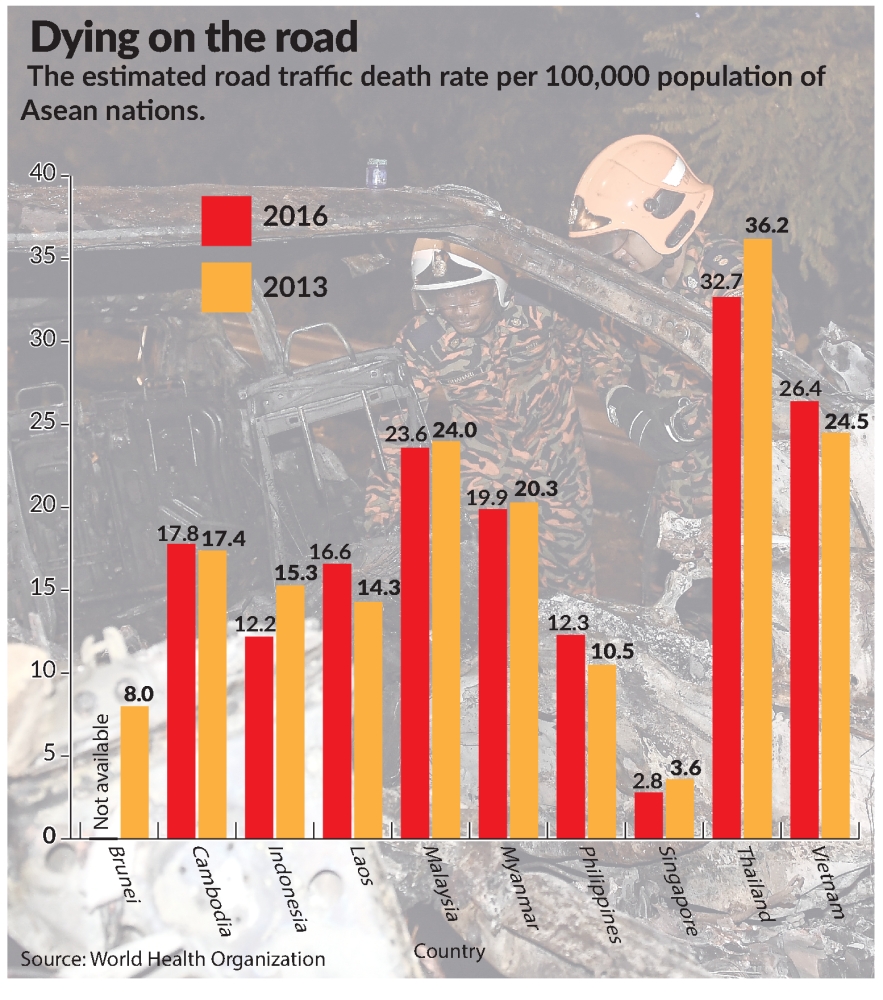The reasons for road traffic accidents are multiple and include rapid urbanisation, poor safety standards, lack of enforcement, people driving distracted or fatigued, influence of psychoactive drugs and alcohol, speeding, and failure to wear seat belts or helmets.
Malaysian data
Malaysia has the third highest fatality rate from road traffic accidents in Asia and Asean, behind Thailand and Vietnam.These fatality rates are similar to that of some African countries.By comparison, the fatality rates in developed countries are all in single digits.Transport accidents (5.4%) were the fourth most common cause of death in Malaysia in 2016, behind ischaemic heart disease (13.2%), pneumonia (12.5%) and cerebrovascular disease (6.9%).It was the third most common cause of death among men behind ischaemic heart disease and pneumonia, according to the Department of Statistics.There has been no change in the Malaysian fatality rates since 2007.The Global Status Report on Road Safety published by the World Health Organization (WHO) and the World Bank in December 2018 reported that Malaysia had 7,152 deaths in 2016, of which 87% were males and 13% females.In the same year, there were 27,613,120 registered vehicles, comprising 13,123,638 cars and four-wheeled light vehicles, 12,677,041 motorised two and three wheelers, 1,191,310 heavy trucks, 59,977 buses and 561,154 other vehicles.
A total of 91% of motorcycle riders wore helmets, but only 87% of their passengers.There was no restriction of the number of children passengers on motorcycles.Front seat belts were worn in 74% of car users and rear seat belts in 10%.There was no trauma registry or assessment of emergency care systems.WHO estimates that for every road traffic death, there are about 15 serious injuries and 70 minor injuries.This means that numerous Malaysian families are affected annually by such deaths, serious injuries, hospitalisations and disabilities.More than half of all road traffic deaths are motorcyclists.A study of motorcycle fatalities reported that the majority were riders (89%), aged 16 to 20 years (22.5%), and 90% of the motorcycles were privately owned.Only 75% of the motorcyclists involved wore helmets.Accidents, traffic accidents, road accidents, death from traffic accidents, car crash, Star2.com
Road safety facts
WHO pointed out several road safety facts that all road users should heed. “Speed kills” is a common warning.The likelihood of a road traffic accident increases with increasing speed – the greater the speed, the more severe the consequences when an accident occurs.For every 1% increase in mean speed, there is a 4% increase in the risk of a fatal accident.A pedestrian hit by a car at 65 kilometres per hour (km/h) is four times more likely to die than if the car was driven at 50 km/h.The average driver driving at 110 km/h will need about 90 metres to come to a stop on a dry surface; longer if the surface is wet.The wearing of a good quality helmet that is well-fastened can reduce the risk of death by 42% and severe injury by about 70%.
The wearing of a seat belt reduces the risk of death and injury for front-seat occupants by 45%-50% and rear-seat occupants by 25%-75%.The use of a telephone, whether handheld or hands-free, increases the risk of an accident by four times, while texting increases the risk by about 23 times.This is because the driver’s reaction time is 50% slower when using a telephone.accidentThe use of child restraints reduces the risk of death by 60%, especially in children below four years of age.Booster seats reduce the risk of injury by 19%, compared to seatbelt alone in children 8- to 12-years-old.Driving under the influence of psychoactive drugs or alcohol increases the risk of death and injuries.
The risk in the former depends on the psychoactive drug used, e.g. the risk of fatality is increased five times with amphetamine.The risk in the latter depends on the blood alcohol concentration (BAC), with a significant increase above a BAC greater than 0.04 g/dl indicating greater risk.Rapid responses with timely care at the site of the accidents, prompt transport to hospital for emergency and surgical care, and easy access to rehabilitation services, saves lives and reduces disability in the injured.It is every road users’ hope that the emergency services have come up to speed since the previous Health Minister Datuk Seri Dr S. Subramaniam’s accident in 2013, where he had to wait 15 minutes before being sent to the hospital after a collision involving his official car and a lorry on the North-South Highway.
A public health issue
Road traffic accidents are preventable and predictable. It is a public health issue that involves several sectors, including health.It is also a social equity issue with vulnerable road users bearing a disproportionate share of risk, injury and fatality.The WHO director-general and the World Bank president stated in the Global Status Report on Road Safety: “Road safety is no accident. It requires strong political will and concerted, sustained efforts across a range of sectors.“Acting now will save lives. We urge governments, as well as other sectors of society, to embrace and implement the key recommendations of this report.”
Dr Milton Lum is a past president of the Federation of Private Medical Practitioners Associations and the Malaysian Medical Association. The views expressed do not represent that of organisations that the writer is associated with. The information provided is for educational and communication purposes only and it should not be construed as personal medical advice. Information published in this article is not intended to replace, supplant or augment a consultation with a health professional regarding the reader’s own medical care. The Star disclaims all responsibility for any losses, damage to property or personal injury suffered directly or indirectly from reliance on such information.
Read more at https://www.star2.com/health/2019/05/14/we-have-the-third-highest-death-rate-from-road-accidents/#DbbGG6GhbV0YoWfo.99

